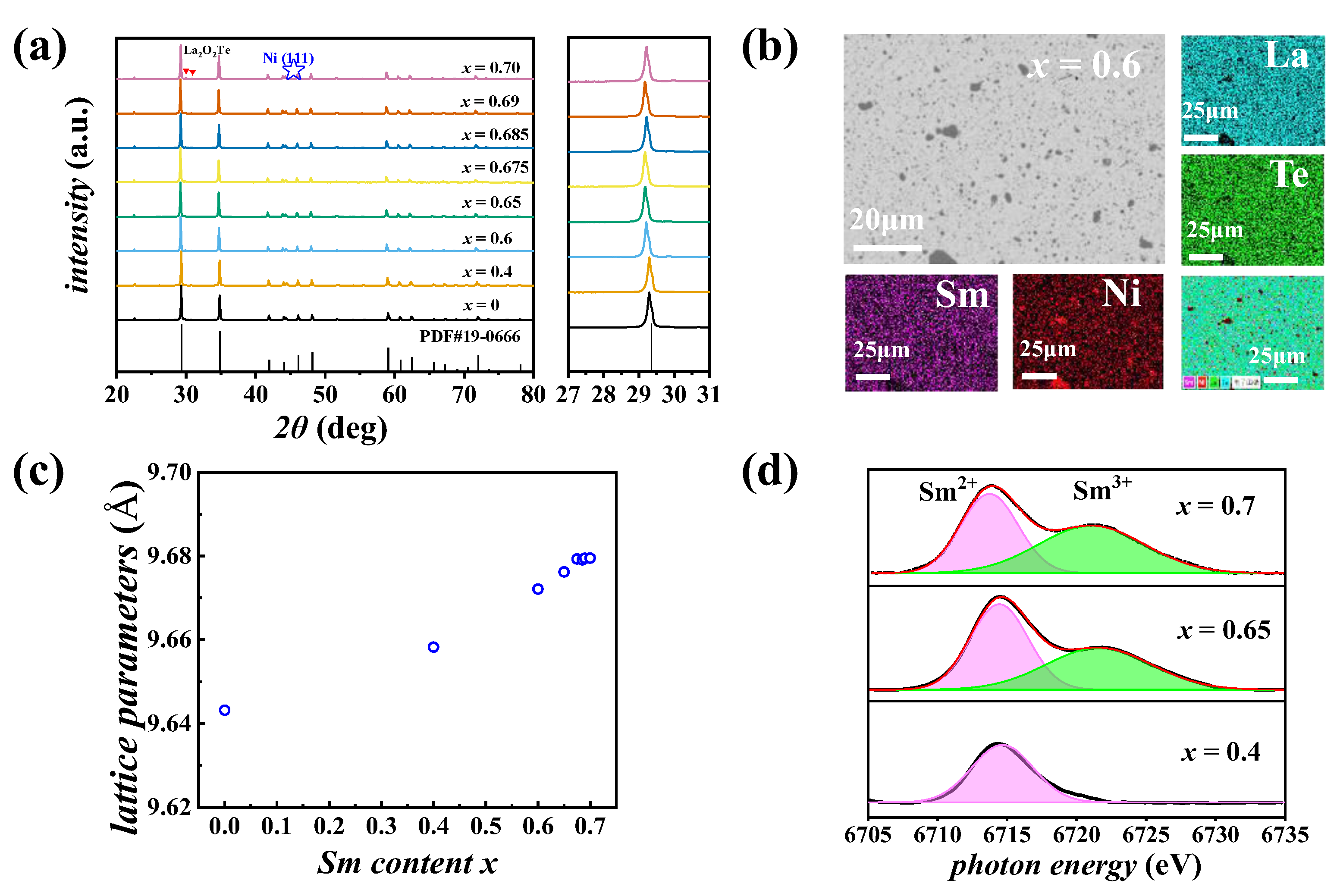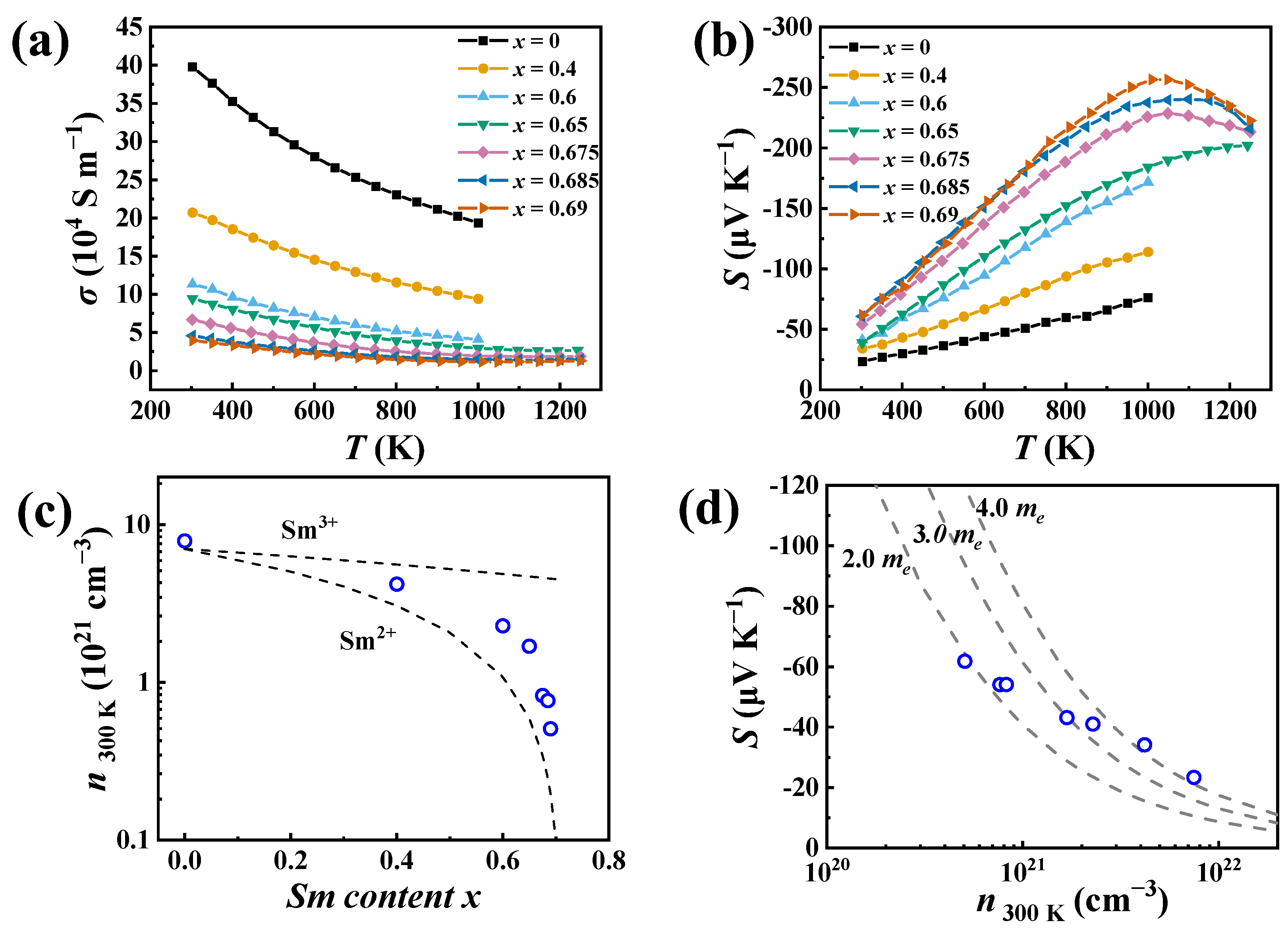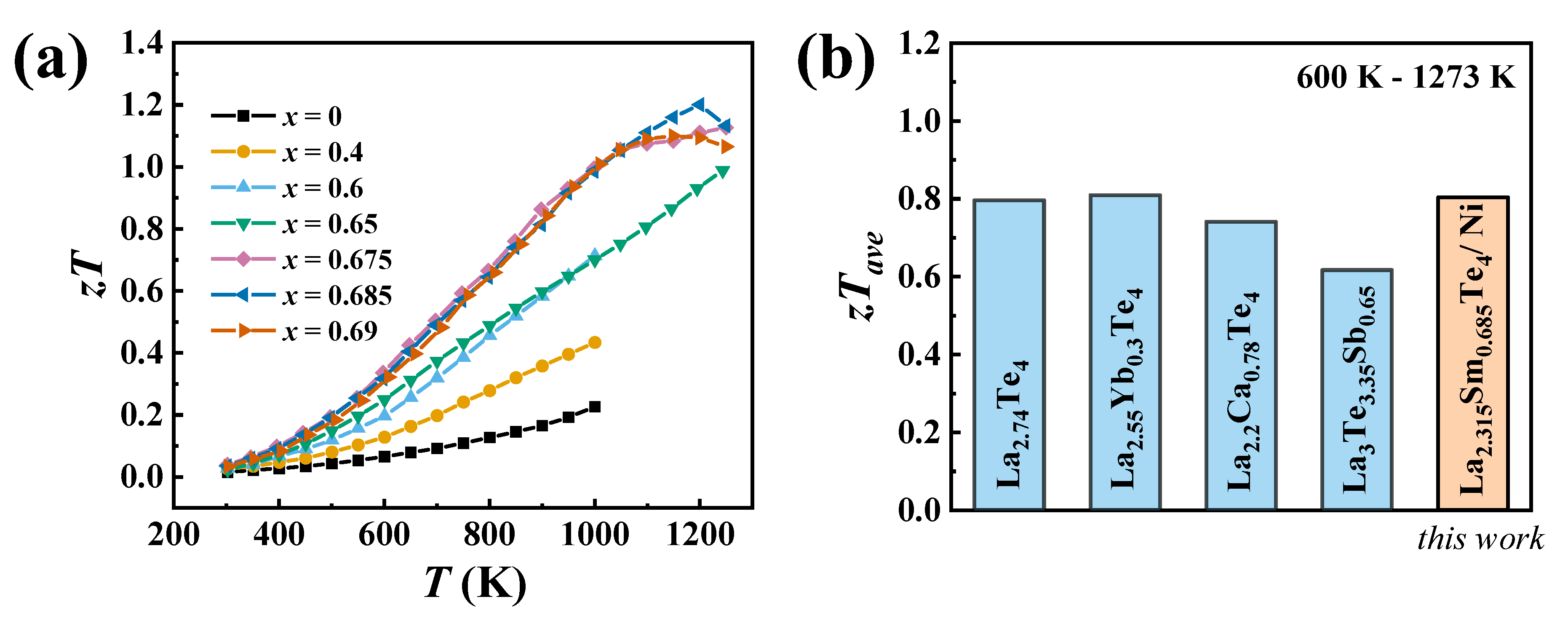Thermoelectric Performance Optimization of n-Type La3−xSmxTe4/Ni Composites via Sm Doping
Abstract
:1. Introduction
2. Materials and Methods
3. Results and Discussion
4. Conclusions
Supplementary Materials
Author Contributions
Funding
Institutional Review Board Statement
Informed Consent Statement
Data Availability Statement
Acknowledgments
Conflicts of Interest
References
- Bennett, G.L.; Rowe, D.M. CRC Handbook of Thermoelectrics; CRC Press: Boca Raton, FL, USA, 1995; p. 720. [Google Scholar]
- Fleurial, J.-P.; Bux, S.; Caillat, T. Engineering of Novel Thermoelectric Materials and Devices for Next Generation, Long Life, 20% Efficient Space Power Systems. In Proceedings of the 11th International Energy Conversion Engineering Conference, San Jose, CA, USA, 15–17 July 2013; p. 3927. [Google Scholar]
- Meng, F.; Chen, L.; Feng, Y.; Xiong, B. Thermoelectric generator for industrial gas phase waste heat recovery. Energy 2017, 135, 83–90. [Google Scholar] [CrossRef]
- Ando Junior, O.; Calderon, N.; de Souza, S. Characterization of a Thermoelectric Generator (TEG) System for Waste Heat Recovery. Energies 2018, 11, 1555. [Google Scholar] [CrossRef] [Green Version]
- Yang, S.; Qiu, P.; Chen, L.; Shi, X. Recent Developments in Flexible Thermoelectric Devices. Small Sci. 2021, 1, 2100005. [Google Scholar] [CrossRef]
- Zoui, M.A.; Bentouba, S.; Stocholm, J.G.; Bourouis, M. A Review on Thermoelectric Generators: Progress and Applications. Energies 2020, 13, 3606. [Google Scholar] [CrossRef]
- Hooshmand Zaferani, S.; Jafarian, M.; Vashaee, D.; Ghomashchi, R. Thermal Management Systems and Waste Heat Recycling by Thermoelectric Generators—An Overview. Energies 2021, 14, 5646. [Google Scholar] [CrossRef]
- Zhang, Q.; Bai, S.; Chen, L. Technologies and Applications of Thermoelectric Devices: Current Status, Challenges and Prospects. J. Inorg. Mater. 2019, 34, 279. [Google Scholar]
- Bu, Z.; Zhang, X.; Hu, Y.; Chen, Z.; Lin, S.; Li, W.; Xiao, C.; Pei, Y. A record thermoelectric efficiency in tellurium-free modules for low-grade waste heat recovery. Nat. Commun. 2022, 13, 237. [Google Scholar] [CrossRef]
- Bu, Z.; Zhang, X.; Hu, Y.; Chen, Z.; Lin, S.; Li, W.; Pei, Y. An over 10% module efficiency obtained using non-Bi2Te3 thermoelectric materials for recovering heat of <600 K. Energy Environ. Sci. 2021, 14, 6506–6513. [Google Scholar] [CrossRef]
- Zhao, K.; Zhu, C.; Qiu, W.; Yang, S.; Su, H.; Qiu, P.; He, Y.; Guan, M.; Wei, T.-R.; Ma, J.; et al. Novel meta-phase arising from large atomic size mismatch. Matter 2022, 5, 605–615. [Google Scholar] [CrossRef]
- Liu, W.; Kim, H.S.; Jie, Q.; Ren, Z. Importance of high power factor in thermoelectric materials for power generation application: A perspective. Scr. Mater. 2016, 111, 3–9. [Google Scholar] [CrossRef] [Green Version]
- Sparks, T.D.; Gaultois, M.W.; Oliynyk, A.; Brgoch, J.; Meredig, B. Data mining our way to the next generation of thermoelectrics. Scr. Mater. 2016, 111, 10–15. [Google Scholar] [CrossRef]
- Hendricks, T.J. Thermoelectric Generator Energy Harvesting Research at NASA-JPL-Where We Are Now and Where We Can Go: Thermoelectric Materials and Systems-From Basic Science to Applications; McMaster Institute of Energy Studies, McMaster University: Hamilton, ON, Canada, 2016. [Google Scholar]
- May, A.F.; Fleurial, J.-P.; Snyder, G.J. Thermoelectric performance of lanthanum telluride produced via mechanical alloying. Phys. Rev. B 2008, 78, 125205. [Google Scholar] [CrossRef] [Green Version]
- May, A.F.; Singh, D.J.; Snyder, G.J. Influence of band structure on the large thermoelectric performance of lanthanum telluride. Phys. Rev. B 2009, 79, 153101. [Google Scholar] [CrossRef]
- Delaire, O.; May, A.F.; McGuire, M.A.; Porter, W.D.; Lucas, M.S.; Stone, M.B.; Abernathy, D.L.; Ravi, V.A.; Firdosy, S.A.; Snyder, G.J. Phonon density of states and heat capacity of La3−xTe4. Phys. Rev. B 2009, 80, 184302. [Google Scholar] [CrossRef]
- Ma, J.M.; Firdosy, S.A.; Kaner, R.B.; Fleurial, J.-P.; Ravi, V.A. Hardness and fracture toughness of thermoelectric La3−xTe4. J. Mater. Sci. 2013, 49, 1150–1156. [Google Scholar] [CrossRef]
- Wang, Y.; Chong, X.; Hu, Y.-J.; Shang, S.-L.; Drymiotis, F.R.; Firdosy, S.A.; Star, K.E.; Fleurial, J.-P.; Ravi, V.A.; Chen, L.-Q.; et al. An alternative approach to predict Seebeck coefficients: Application to La3−xTe4. Scr. Mater. 2019, 169, 87–91. [Google Scholar] [CrossRef]
- Cheikh, D. Synthesis and Characterization of Rare-Earth Tellurides and Their Composites for High Temperature Thermoelectric Applications. Ph.D. Thesis, University of California, Los Angeles, CA, USA, 2017. [Google Scholar]
- Karim, A.V.; Hassani, A.; Eghbali, P.; Nidheesh, P.V. Nanostructured modified layered double hydroxides (LDHs)-based catalysts: A review on synthesis, characterization, and applications in water remediation by advanced oxidation processes. Curr. Opin. Solid State Mater. Sci. 2022, 26, 100965. [Google Scholar] [CrossRef]
- Ma, J.M.; Clarke, S.M.; Zeier, W.G.; Vo, T.; Von Allmen, P.; Snyder, G.J.; Kaner, R.B.; Fleurial, J.P.; Bux, S.K. Mechanochemical synthesis and high temperature thermoelectric properties of calcium-doped lanthanum telluride La3−xCaxTe4. J. Mater. Chem. C 2015, 3, 10459–10466. [Google Scholar] [CrossRef] [Green Version]
- May, A.F.; Fleurial, J.-P.; Snyder, G.J. Optimizing Thermoelectric Efficiency in La3−xTe4 via Yb Substitution. Chem. Mater. 2010, 22, 2995–2999. [Google Scholar] [CrossRef]
- May, A.F.; Flage-Larsen, E.; Snyder, G.J. Electron and phonon scattering in the high-temperature thermoelectric La3Te4−zMz (M = Sb, Bi). Phys. Rev. B 2010, 81, 125205. [Google Scholar] [CrossRef] [Green Version]
- Nakahara, J.F.; Takeshita, T.; Tschetter, M.J.; Beaudry, B.J.; Gschneidner, K.A. Thermoelectric properties of lanthanum sulfide with Sm, Eu, and Yb additives. J. Appl. Phys. 1988, 63, 2331–2336. [Google Scholar] [CrossRef]
- Boucherle, J.-X.; Givord, F.; Schweizer, J.; Gukasov, A.; Mignot, J.-M.; vre-Berna, E.L.; Aoki, H.; Ochiai, A. Polarized neutron investigation in the mixed-valence compound Sm3Te4. Phys. B 1999, 267, 37–40. [Google Scholar] [CrossRef]
- Li, J.; Liu, R.; Song, Q.; Gao, Z.; Huang, H.; Zhang, Q.; Shi, X.; Bai, S.; Chen, L. Enhanced thermal stability and oxidation resistance in La3-xTe4 by compositing metallic nickel particles. Acta Mater. 2021, 224, 117526. [Google Scholar] [CrossRef]
- Eghbali, P.; Hassani, A.; Sündü, B.; Metin, Ö. Strontium titanate nanocubes assembled on mesoporous graphitic carbon nitride (SrTiO3/mpg-C3N4): Preparation, characterization and catalytic performance. J. Mol. Liq. 2019, 290, 111208. [Google Scholar] [CrossRef]
- Mizumaki, M.; Tsutsui, S.; Iga, F. Temperature dependence of Sm valence in SmB6 studied by X-ray absorption spectroscopy. J. Phys. Conf. Ser. 2009, 176, 012034. [Google Scholar]
- Yoshikane, N.; Matsui, K.; Nakagawa, T.; Terzidou, A.G.V.; Takabayashi, Y.; Yamaoka, H.; Hiraoka, N.; Ishii, H.; Arvanitidis, J.; Prassides, K. Pressure-induced valence transition in the mixed-valence (Sm1/3Ca2/3)2.75C60 fulleride. Mater. Chem. Front. 2020, 4, 3521–3528. [Google Scholar] [CrossRef]
- Sousanis, A.; Poelman, D.; Detavernier, C.; Smet, P.F. Switchable Piezoresistive SmS Thin Films on Large Area. Sensors 2019, 19, 4390. [Google Scholar] [CrossRef] [Green Version]
- Gomez, S.J.; Cheikh, D.; Vo, T.; Von Allmen, P.; Lee, K.; Wood, M.; Snyder, G.J.; Dunn, B.S.; Fleurial, J.-P.; Bux, S.K. Synthesis and Characterization of Vacancy-Doped Neodymium Telluride for Thermoelectric Applications. Chem. Mater. 2019, 31, 4460–4468. [Google Scholar] [CrossRef] [Green Version]
- Kim, H.-S.; Gibbs, Z.M.; Tang, Y.; Wang, H.; Snyder, G.J. Characterization of Lorenz number with Seebeck coefficient measurement. APL Mater. 2015, 3, 041506. [Google Scholar] [CrossRef] [Green Version]
- Cahill, D.G.; Watson, S.K.; Pohl, R.O. Lower limit to the thermal conductivity of disordered crystals. Phys. Rev. B Condens. Matter. 1992, 46, 6131–6140. [Google Scholar] [CrossRef]
- Callaway, J. Model for Lattice Thermal Conductivity at Low Temperatures. Phys. Rev. 1959, 113, 1046–1051. [Google Scholar] [CrossRef]
- Callaway, J.; von Baeyer, H.C. Effect of Point Imperfections on Lattice Thermal Conductivity. Phys. Rev. 1960, 120, 1149–1154. [Google Scholar] [CrossRef]
- Yang, J.; Meisner, G.P.; Chen, L. Strain field fluctuation effects on lattice thermal conductivity of ZrNiSn-based thermoelectric compounds. Appl. Phys. Lett. 2004, 85, 1140–1142. [Google Scholar] [CrossRef]
- Holland, M.G. Phonon Scattering in Semiconductors From Thermal Conductivity Studies. Phys. Rev. 1964, 134, A471–A480. [Google Scholar] [CrossRef]




Publisher’s Note: MDPI stays neutral with regard to jurisdictional claims in published maps and institutional affiliations. |
© 2022 by the authors. Licensee MDPI, Basel, Switzerland. This article is an open access article distributed under the terms and conditions of the Creative Commons Attribution (CC BY) license (https://creativecommons.org/licenses/by/4.0/).
Share and Cite
Li, J.; Song, Q.; Liu, R.; Dong, H.; Zhang, Q.; Shi, X.; Bai, S.; Chen, L. Thermoelectric Performance Optimization of n-Type La3−xSmxTe4/Ni Composites via Sm Doping. Energies 2022, 15, 2353. https://doi.org/10.3390/en15072353
Li J, Song Q, Liu R, Dong H, Zhang Q, Shi X, Bai S, Chen L. Thermoelectric Performance Optimization of n-Type La3−xSmxTe4/Ni Composites via Sm Doping. Energies. 2022; 15(7):2353. https://doi.org/10.3390/en15072353
Chicago/Turabian StyleLi, Jian, Qingfeng Song, Ruiheng Liu, Hongliang Dong, Qihao Zhang, Xun Shi, Shengqiang Bai, and Lidong Chen. 2022. "Thermoelectric Performance Optimization of n-Type La3−xSmxTe4/Ni Composites via Sm Doping" Energies 15, no. 7: 2353. https://doi.org/10.3390/en15072353
APA StyleLi, J., Song, Q., Liu, R., Dong, H., Zhang, Q., Shi, X., Bai, S., & Chen, L. (2022). Thermoelectric Performance Optimization of n-Type La3−xSmxTe4/Ni Composites via Sm Doping. Energies, 15(7), 2353. https://doi.org/10.3390/en15072353





